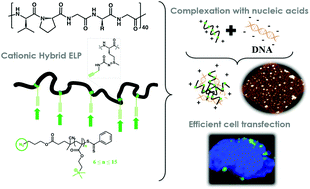Coupling of RAFT polymerization and chemoselective post-modifications of elastin-like polypeptides for the synthesis of gene delivery hybrid vectors†
Abstract
Hybrids of synthetic polymers and biopolymers are known to be macromolecular systems that merge the properties of each component and overcome some of their intrinsic limitations. Elastin-like polypeptides (ELPs) are a class of biopolymers known for their genetically-encoded synthesis, monodispersity, biocompatibility and absence of toxicity, which are very attractive features for biological applications. However, the presence of numerous amino acid residues presenting electrically charged side chains within the ELP sequence makes the purification of these ELPs by Inverse Transition Cycling (ITC) difficult to achieve. Positively charged ELPs are of great interest for the design of polyelectrolyte complexes dedicated to the transport and delivery of genetic material. In this work, an ELP containing periodically spaced methionine residues was recombinantly expressed, and these residues were chemoselectively modified at the thioether side chains to introduce alkyne groups. In parallel, four cationic oligomers with different chain lengths were synthesized by Reversible Addition–Fragmentation chain Transfer (RAFT) polymerization using a chain transfer agent containing an azido group. Hybrid cationic ELPs were finally obtained by covalent coupling of the cationic oligomers onto the ELP by Huisgen azide–alkyne cycloaddition reaction. The different hybrid cationic ELPs were characterized by 1H NMR, ζ-potential and SEC analyses to assess their purity and determine their degree of functionalization, overall charge and molar mass. Then, electrostatic complexation was achieved between these hybrid cationic ELPs and plasmid DNA, allowing the determination of the optimal conditions for obtaining stable nanoparticles having a controlled size and surface potentials at different N+/P− charge ratios. Preliminary biological tests showed the reliability of such hybrid cationic ELPs to internalize efficiently genetic material into living cells.



 Please wait while we load your content...
Please wait while we load your content...